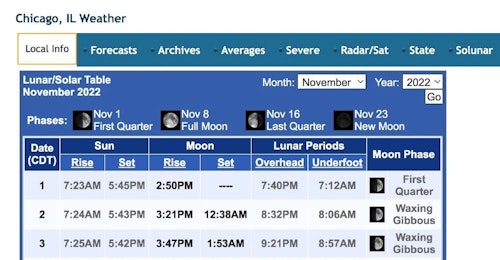If you want to start an argument at deer camp, then bring up the topic of whether the moon affects whitetail deer movement.
While scientific studies referenced by the National Deer Association and other reputable organizations indicate that the moon does NOT play a meaningful role in deer movement, many well-respected whitetail hunters believe otherwise.
Search “red moon deer movement” on YouTube and you can spend hours listening to hunters such as Adam Hayes who believe that moon position — not moon phase — can be a major player in deer movement, especially as it pertains to mature bucks. (Click here to learn from Adam Hayes about the red moon.)
The “red moon” has nothing to do with the moon’s apparent color; it’s a term used by Hayes and others to call out those special few days each month when the moon (regardless of phase) is directly overhead or underfoot (when the moon’s gravitational influence are strongest), AND those specific times coincide with the prime hunting periods near sunrise and sunset (when deer are most likely to be moving naturally to and from feeding areas).
For example, let’s say that on a particular day in late October, the moon will be underfoot at 8 a.m. And let’s say sunrise is at 7:30 a.m. If the weather is decent for deer movement (not too hot, too windy, too rainy, etc.) this “red moon” day is a prime time to be in a treestand. The moon underfoot matches up well with the usual prime time for deer movement (sunrise in this case).
Another example: Let’s say sunset is at 7:30 p.m. in late September. And let’s say the moon will be overhead at 7 p.m. Again, this would be considered a “red moon” day because the moon overhead matches up (within a couple hours) of a prime time for natural deer movement (in this case, sunset).
It’s important to note that “natural deer movement” (to and from food sources) is generally around sunrise and sunset throughout much of the hunting season, but all of this can change dramatically during the breeding period. Rutting whitetail bucks can be on their feet searching for a doe in heat at any time during early to mid-November. That said, those hunters who believe in the moon’s influence on deer movement think you can still match the moon overhead and underfoot times to maximize your chance for success in the field.
For example, in mid-November, let’s say moon underfoot happens at 11 a.m. Assuming the weather is decent (not too hot, too windy, too rainy, etc.), you should probably be in a treestand from 10 a.m. to 2 p.m. to increase your chance of seeing a cruising rutting buck.
Of course, moon position is no guarantee for predicting deer movement. But many diehard deer hunters take advantage of these “red moon” days, and it’s hard to argue with their results. (You can purchase the MoonGuide in several forms, including an app, but you can also find moon overhead and underfoot times for free online. For example, click here for the moon overhead and underfoot times for Chicago, Illinois. You simply enter a city of your choice, then click “Solunar” then “Monthly Sun & Moon.”)

Check out the short “Before the Echo” video below where Dan Infalt, whose YouTube channel is called The Hunting Beast, talks about moon position and whether he factors it into his deer hunts. (Infalt is in the top right of the video.)






